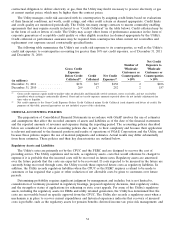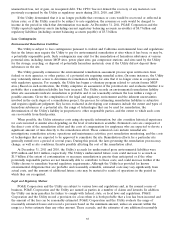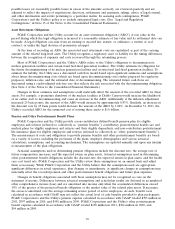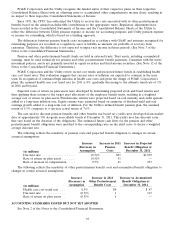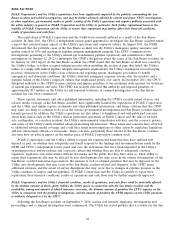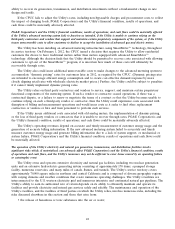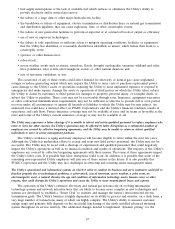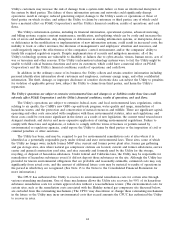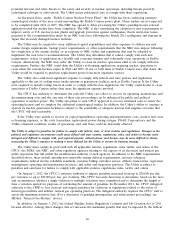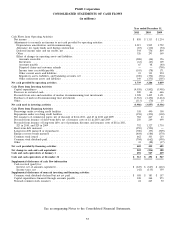PG&E 2011 Annual Report Download - page 48
Download and view the complete annual report
Please find page 48 of the 2011 PG&E annual report below. You can navigate through the pages in the report by either clicking on the pages listed below, or by using the keyword search tool below to find specific information within the annual report.Utility’s customers may increase the risk of damage from a system-wide failure or from an intentional disruption of
the system by third parties. The failure of these information systems and networks could significantly disrupt
operations; result in outages; reduced generating output; damage to the Utility’s assets or operations or those of
third parties on which it relies; and subject the Utility to claims by customers or third parties, any of which could
have a material effect on PG&E Corporation’s and the Utility’s financial condition, results of operations, and cash
flows.
The Utility’s information systems, including its financial information, operational systems, advanced metering,
and billing systems, require constant maintenance, modification, and updating, which can be costly and increases the
risk of errors and malfunction. Any disruptions or deficiencies in existing information systems, or disruptions, delays
or deficiencies in the modification or implementation of new information systems, could result in increased costs, the
inability to track or collect revenues, the diversion of management’s and employees’ attention and resources, and
could negatively impact the effectiveness of the companies’ control environment, and/or the companies’ ability to
timely file required regulatory reports. Despite implementation of security and mitigation measures, all of the
Utility’s technology systems are vulnerable to disability or failures due to cyber-attacks, viruses, human errors, acts of
war or terrorism and other reasons. If the Utility’s information technology systems were to fail, the Utility might be
unable to fulfill critical business functions and serve its customers, which could have a material effect on PG&E
Corporation’s and the Utility’s financial conditions, results of operations, and cash flows.
In addition, in the ordinary course of its business, the Utility collects and retains sensitive information including
personal identification information about customers and employees, customer energy usage, and other confidential
information. The theft, damage, or improper disclosure of sensitive electronic data can subject the Utility to penalties
for violation of applicable privacy laws, subject the Utility to claims from third parties, and harm the Utility’s
reputation.
The Utility’s operations are subject to extensive environmental laws and changes in or liabilities under these laws could
adversely affect PG&E Corporation’s and the Utility’s financial conditions, results of operations, and cash flows.
The Utility’s operations are subject to extensive federal, state, and local environmental laws, regulations, orders,
relating to air quality, the CARB’s new GHG cap-and-trade program, water quality and usage, remediation of
hazardous wastes, and the protection and conservation of natural resources and wildlife. There are significant capital,
operating and other costs associated with compliance with these environmental statutes, rules and regulations, and
those costs could be even more significant in the future as a result of new legislation, the current trend toward more
stringent standards, and stricter and more expansive application of existing environmental regulations. Failure to
comply with these laws and regulations, or failure to comply with the terms of licenses or permits issued by
environmental or regulatory agencies, could expose the Utility to claims by third parties or the imposition of civil or
criminal penalties or other sanctions.
The Utility has been, and may be, required to pay for environmental remediation costs at sites where it is
identified as a potentially responsible party under federal and state environmental laws. These sites, some of which
the Utility no longer owns, include former MGP sites, current and former power plant sites, former gas gathering
and gas storage sites, sites where natural gas compressor stations are located, current and former substations, service
center and general construction yard sites, and sites currently and formerly used by the Utility for the storage,
recycling, or disposal of hazardous substances. Under federal and California laws, the Utility may be responsible for
remediation of hazardous substances even if it did not deposit those substances on the site. Although the Utility has
provided for known environmental obligations that are probable and reasonably estimable, estimated costs may vary
significantly from actual costs, and the amount of additional future costs may be material to results of operations in
the period in which they are recognized. (See Note 15 to the Notes to the Consolidated Financial Statements for
more information.)
The CPUC has authorized the Utility to recover its environmental remediation costs for certain sites through
various ratemaking mechanisms. One of these mechanisms allows the Utility rate recovery for 90% of its hazardous
substance remediation costs for certain approved sites without a reasonableness review. (The environmental costs for
certain sites, such as the remediation costs associated with the Hinkley natural gas compressor site discussed below,
are excluded from this ratemaking mechanism.) The CPUC may discontinue or change these ratemaking mechanisms
in the future or the Utility may incur environmental costs that exceed amounts the CPUC has authorized the Utility
to recover in rates.
44


